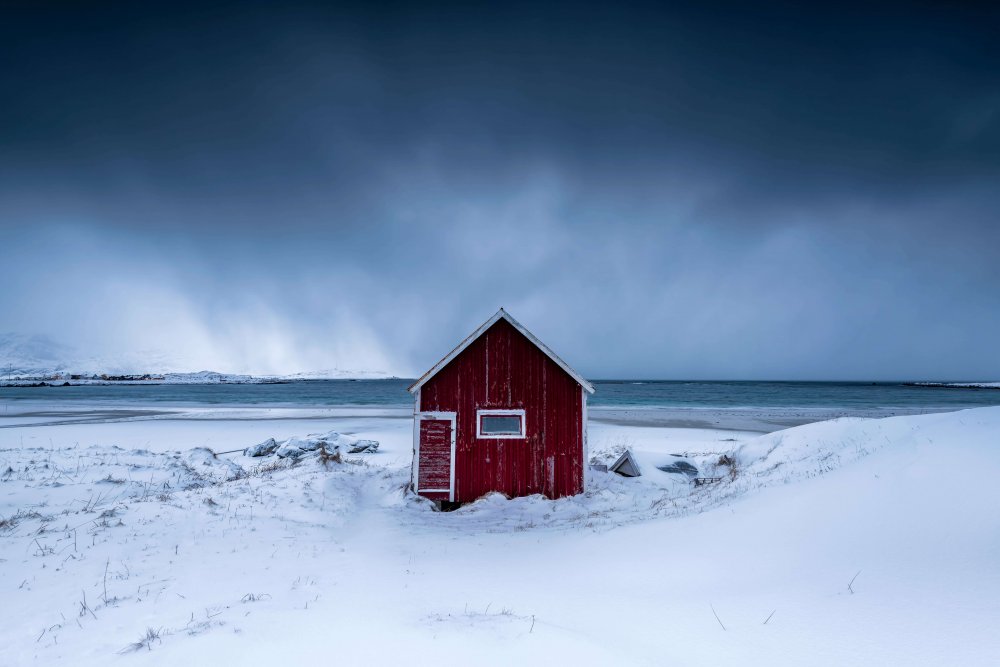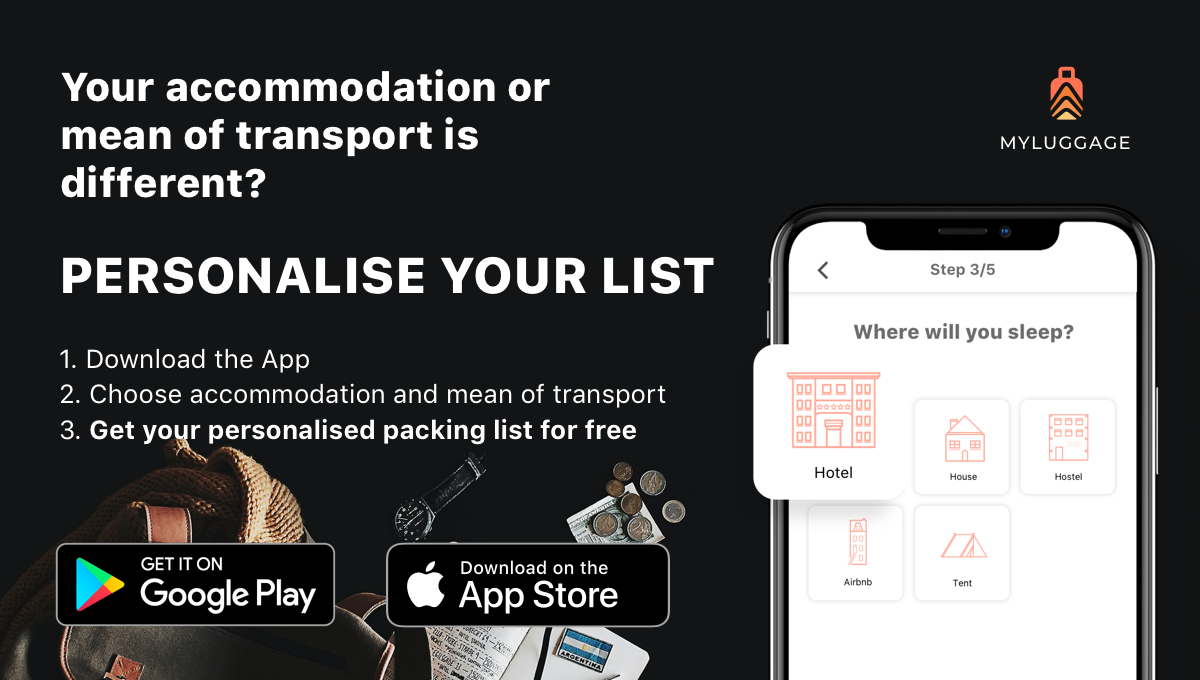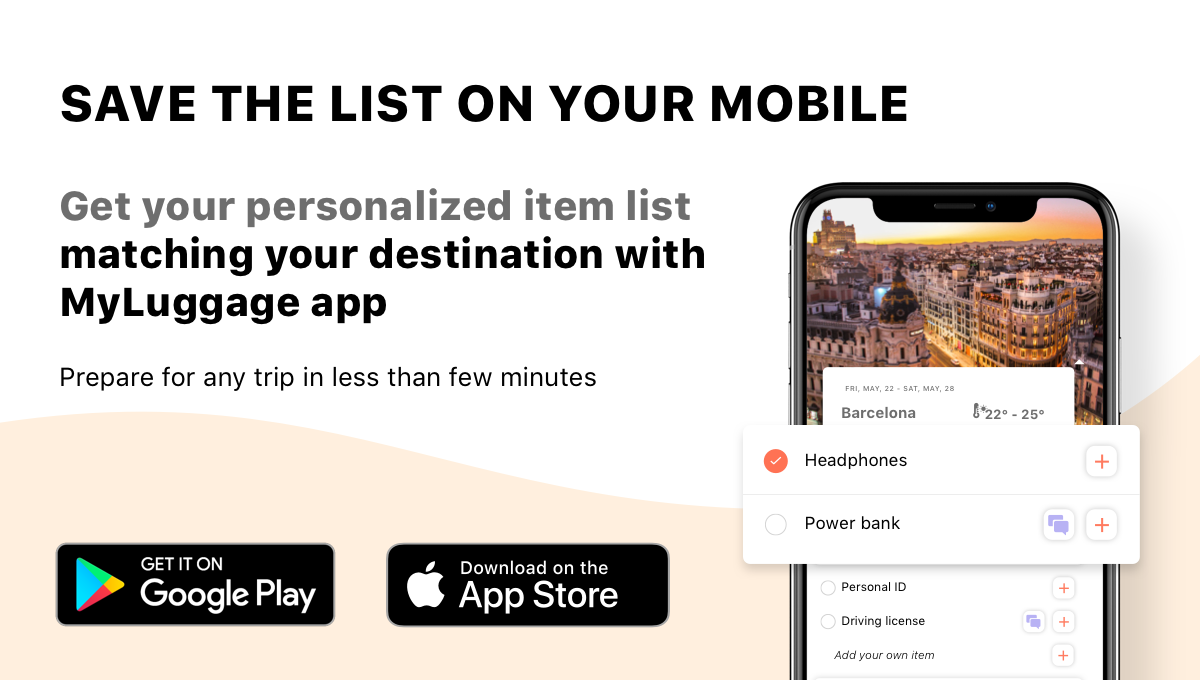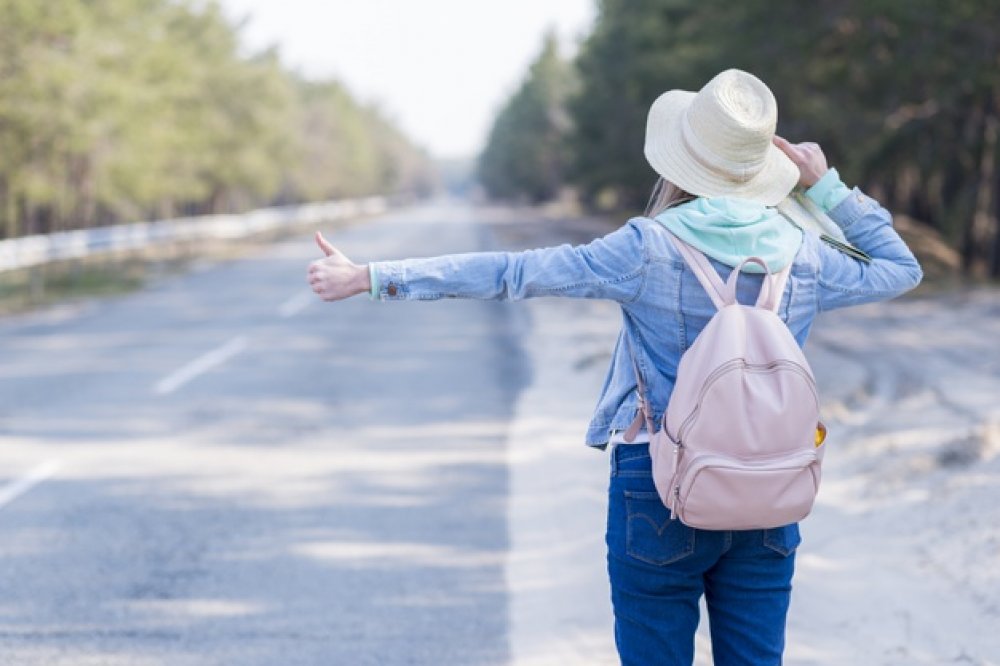
Travel guide
Norway is a beautiful and fascinating travel destination, which attracts more and more tourists every year, who seek extraordinary landscapes, interesting culture and picturesque views. From bustling Oslo, through quiet mountain towns, ending with wild fjords, which are the most characteristic element of Norway - everyone will find something for themselves there. Check what to pack for a trip to Norway and what to know before going there to make your trip unforgettable.
Travel information
|

|
Destination
|
Leisure and sightseeing
|
|

|
Trip length
|
3 nights |
|

|
Transport
|
Car
|
|

|
Sleep
|
Airbnb
|
|

|
Luggage
|
Suitcase
|
Travel information
The most useful items
Travelers who are not properly prepared for their trip to Norway may be unpleasantly surprised upon arrival in that country - although summer can be extremely warm there, the weather and temperature can change very quickly. That is why we would like to remind you about a few key things to pack into a suitcase or backpack, that will ensure a stress-free trip to Norway:
- Masks and antibacterial gel - nowadays both disposable or reusable masks and antibacterial gel are inseparable elements of our luggage. Remember to have at least two disposable masks or enough reusable masks to wash and dry them for each day of travel.
- Documents - we need an ID card to cross the Norwegian border. Remember to also pack your driving license if you plan to rent a car. We strongly recommend this solution if you want to reach more secluded, picturesque locations.
- Warm clothing - a wool sweatshirt, a rain jacket and clothes that will allow us to wear few layers is a must when traveling in Norway. The temperature can change quickly and you never know when the rain will surprise you.
- Comfortable trekking shoes - under no circumstances pack newly purchased shoes in your luggage. This is a simple recipe for bruises that will make hiking impossible. Most of the hiking trails in Norway are sometimes wet, so you should take waterproof shoes with you.
- Norwegian kroner - that’s the currency in Norway. We recommend buying it in a safe exchange office, where we will not overpay for currency conversion. It is also worth considering purchasing a currency card, which will allow us to save a lot of money.
- Snacks and drinks - if we travel to Norway by car, and we want to cut our expenses significantly, it is worth thinking about ... packing some packed snacks. Norway, like whole Scandinavia, is quite an expensive country - the prices in restaurants and supermarkets may surprise us unpleasantly. Therefore, when planning longer hikes, it is worth stocking up on protein bars and other snacks bought in your country.
Packing list
LUGGAGE TYPE: Suitcase
DOCUMENTS
- Travel insurance
- Wallet
- Health insurance
- ID card
- Credit card
- House keys
- Cash

UNDERWEAR
- Socks x3
- Pants x3
- Sleepwear / Pajamas
SHOES
- Flip-flops / slippers
- Comfortable shoes
CLOTHES
- T-Shirt x2
- Trouser belt
- Summer jacket
- Hoodie
- Trousers
COSMETICS
- Shower gel
- Shampoo
- Toothbrush
- Toothpaste
- Perfume
- Antiperspirant
FIRST AID KIT
- Contraceptives
- Prescription drugs
- An anti-diarrheal drug
- Painkiller
- Pills for sore throat
- Patches
ACCESSORIES
- Hairband
- Power bank
- Phone
- Glasses box
- Sunglasses
- Telephone
- Cotton mask
- Headphones
- Phone charger

What should you eat when visiting Norway?
It is true that Norway is known more for its landscapes than gastronomy, but this doesn’t mean that fans of cuisine will not find something for themselves there. Here are some local dishes and products that you must try when going on a trip to Norway:
- Brunost - an extremely popular Norwegian cheese. It has a characteristic brown color and is eaten both salty, for example in sandwiches or sauces, and ... sweet, in waffles. It's definitely worth trying! Most people describe its taste as toffee or fudge.
- Frokost - a Norwegian breakfast. It's worth trying it at least once while traveling. Breakfast includes dark Norwegian bread, 3-4 add-ons and a drink. What additions do the Norwegians choose? Among other things, the already mentioned brunost, but also local jams, hams or delicious chocolate.
- Tørrfisk --dried fish, most often cod. Drying in the sun is a popular method of preserving meat in Norway - typical of this region and definitely worth testing.
- Fiskepuddig - another fish dish. Fish pudding, eaten both hot as a main course and cold. It has both its fans and anti fans, but one thing is certain - it is an interesting culinary experience.
- Sveler - small, fluffy cakes, resembling pancakes. Eaten both hot and cold, with jam, cheese or sour cream.
- Spekemat - various types of dried, salted sausages, for example a leg of mutton or… reindeer or elk salami. Something for those thirsty for unusual, culinary experiences!
 (1).jpg)
How much money should you take with you?
Unfortunately, Norway is considered a very expensive country. We must be ready either to spend large amounts of money practically at every turn, or to save and buy in large supermarkets or on promotions.
- Shops KIWI and Rema 1000 are considered the cheapest supermarkets in Norway. Pay attention to the word “tilbud”, which means promotion.
- For a meal in a chain restaurant, for example a pizza, we will pay from 15 EUR up.
- The cost of beer in a pub is a minimum of 5 EUR, and for a coffee we will pay a minimum of EUR 4.
- Public transport tickets are also relatively expensive - a single ticket in Oslo costs EUR 4. However, it is worth remembering that we will pay about EUR 2 for a liter of fuel, so we must reasonably calculate our budget for transport.
Safety
- Norwegians are considered quite good drivers and they usually obey the law.
- Norway is not a particularly touristic place and is considered a relatively safe country, but as always - watch out for pickpockets, do not ostentatiously carry a camera or an expensive phone with you, use common sense and pay attention when meeting new people, especially in large cities.
 (1).jpg)
Useful information
- Remember that shops in Norway are closed on Sunday.
- If you are planning a day hike out in the open air or trekking and you think about packing a knife - be careful! In Norway, carrying a knife with a blade longer than 7 centimeters is treated by the police on a par with carrying a weapon illegally.
- 97% of Norway's land area is forests, mountains and lakes.
- If you want to observe the Northern Lights, October, February and March are ideal times.
- Although the dates of the polar days and nights vary depending on the longitude we go to - the polar day usually starts between April and May, and the polar night lasts from October to February.
- Norwegians are not considered to be very outgoing, but they are a very polite and helpful nation. Don't be offended when you have the impression that they are not friendly towards you - they are really helpful and nice.
Norway is a country that delights with its landscapes, and the view of the fjords will be remembered forever! Regardless of whether you are planning an active sightseeing in Oslo, or maybe you prefer to go hiking in the wild, beautiful forests and shores of Norway - remember that the right luggage is essential. So download the MyLuggage app and let us prepare a personalized packing list for you - and plan your unforgettable trip to the North of Europe!



 (1).jpg)
 (1).jpg)